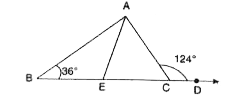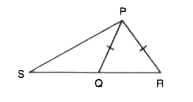त्रिभुज ABC की भुजा BC को D तक बढ़ाया गया है। ∠A का समद्विभाजक BC से L पर मिलता है। सिद्ध कीजिये कि ∠ABC+∠ACD=2∠ALC

Step by step video & image solution for त्रिभुज ABC की भुजा BC को D तक बढ़ाया गया है। angleA का समद्विभाजक BC से L पर मिलता है। सिद्ध कीजिये कि angleABC + angleACD = 2angleALC by Maths experts to help you in doubts & scoring excellent marks in Class 9 exams.
Topper's Solved these Questions
- BOOK - S CHANDCHAPTER - त्रिभुज EXERCISE - प्रश्नावली 18.2 रिक्त स्थानों को भरे :5videos
त्रिभुज
- BOOK - S CHANDCHAPTER - त्रिभुज EXERCISE - प्रश्नावली 18.1 सत्य-असत्य6videos
त्रिभुज
- BOOK - S CHANDCHAPTER - त्रिकोणमितीय EXERCISE - प्रश्नावली 27.311videos
त्रिकोणमितीय
- BOOK - S CHANDCHAPTER - त्रिभुज में असमिकाएँ EXERCISE - प्रश्नावली 21. 81videos
त्रिभुज में असमिकाएँ
Similar Questions
यदि ∠ACD=124∘,∠ABC=36∘, तो ∠BAC=………….
 01:37View Solution
01:37View Solutionएक त्रिभुज का बहिष्कोण त्रिभुज के किसी एक अंत: अभिमुख कोण से छोटा होता है।
06:07View Solutionत्रिभुज ABC में कोण B समकोण है। त्रिभुज के शेष अवयव ज्ञात कीजिए यदि :
∠C=45∘,AB=5 सेमी02:11View Solutionआकृति में, PQ = PR, तो सिद्ध करें कि PS>PQ
 01:31View Solution
01:31View SolutionHow many lines of symmetry does the above figure have ?
02:45View SolutionWhich of the following are correct chain isomers of butane ? (i)
02:17View SolutionDetermine the point of symmetry of a regular hexagon.
05:41View SolutionDtermine the images of the following figure about the given line :
02:10View SolutionMatch the following Column A to Column B
 02:17View Solution
02:17View SolutionMatch the following Column A to Column B
 02:10View Solution
02:10View SolutionMatch the following Column A to Column B
 04:23View Solution
04:23View SolutionThe inequation represented by the graph given below is :
03:28View SolutionThe inequation that best describes the graph given below is _________
03:37View SolutionThe inequation that best describes the following graph is _________
01:19View SolutionWhich inequations represent the shaded region in the given figure
06:12View SolutionIn the given figure, ¯¯¯¯¯¯AD and ¯¯¯¯¯¯BE intersect at C, such that BC = CE, ∠ABC=40∘ and ∠DEC=85∘. Find ∠BAC−∠CDE.
ltimg src="https://d10lpgp6xz60nq.cloudfront.net/physics_images/PS_MATH_IX_C12_E04_027_Q01.png" width="80%"gt03:10View Solution

